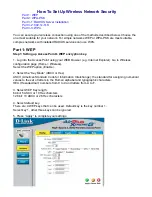
RAD-ISM-900-EN-BD…
4-10
PHOENIX CONTACT
2476_en_I
Community Settings:
The community setting is a string of up to 30 characters. The
community name acts as a password and is used to authenticate messages sent between
an SNMP slave and a device containing an SNMP server. The community name is sent in
every packet between the slave and the server.
Source:
(IP Access List) The IP access list identifies those IP addresses of SNMP
managers permitted to use a given SNMP community. An example of the network address
format is 192.168.42.182/24. The subnet mask of the network is typically annotated in
written form as a “slash prefix” that trails the network number.
Access Control:
Sets the read/write access for the community.
Secure User Configuration Settings:
This is the configuration for SNMP version 3.
User Name:
A string of up to 30 characters.
Authentication Type:
Indicates the algorithm used for authentication; it can be either MD5
or SHA, the latter one being the better algorithm.
Authentication Key:
A string of characters used for authentication. Maximum length is
42 characters.
Encryption Type:
Defines the encryption algorithm used by the SNMP protocol, and it can
be either DES or AES. AES is the strongest encryption algorithm.
Encryption Key:
A string of up to 32 characters.
System Information:
Location:
The device’s physical location, a string of up to 64 characters.
Contact:
The person who manages the device, a string of up to 64 characters.
Engine ID:
Each SNMPv3 agent has an engine ID that uniquely identifies the agent in
the device. The engine ID may be set by the network administrator and is unique to that
internal network. It is a string of up to 48 characters.
Click the “Submit” button to write the configuration to the radio.
4.9
Configuring the Network Filter
The RAD-ISM-900-EN-BD… has the capability of allowing or denying data packets to pass
through an Ethernet port and then be broadcast over the wireless network. Packets can be
filtered by IP address or by MAC address. Without the Network Filter, Ethernet traffic that is
not destined for a remote device connected to a slave radio will be broadcast over-the-air.
This uses up bandwidth and may pose a security risk. The Network Filter allows a user to
ensure only packets destined for remote devices connected via the radio link are sent over-
the-air.
RSPSupply - 1-888-532-2706 - www.RSPSupply.com
http://www.RSPSupply.com/p-12970-Phoenix-Contact-2900016-Radio-900-MHz-Ethernet-Radio.aspx
















































